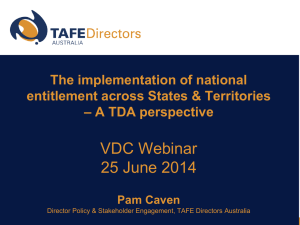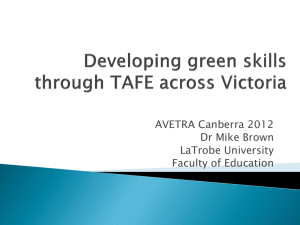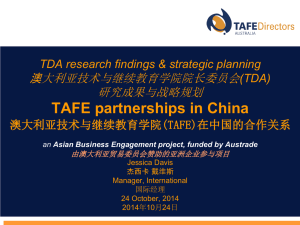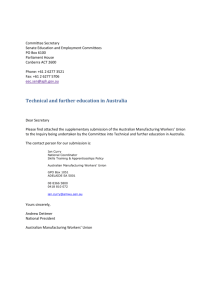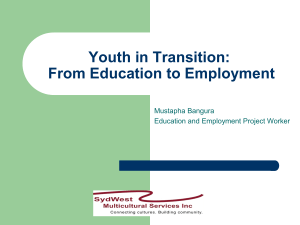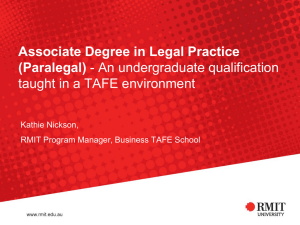PPT - TAFE Directors Australia
advertisement
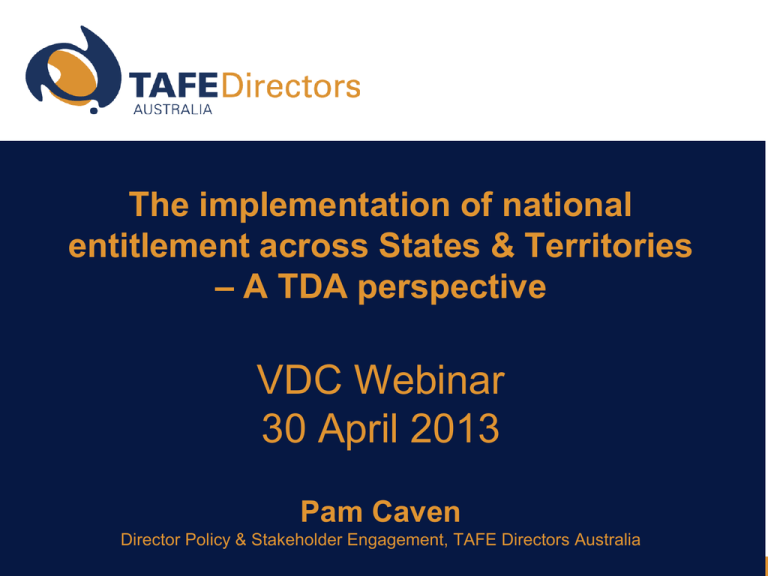
The implementation of national entitlement across States & Territories – A TDA perspective VDC Webinar 30 April 2013 Pam Caven Director Policy & Stakeholder Engagement, TAFE Directors Australia Australian State and Territory governments’ policy drivers. • • • the pursuit of economic growth & productivity strategies to reduce the deficit a belief in markets (and in some cases the small state) TAFE Directors Australia’s position • • • • The role of the public provider ought to be affirmed and clearly articulated There ought to be appropriate administrative and funding arrangements in place to support this role 5,000+ providers poses a threat to quality and to the VET Brand ASQA should take risk oriented approach to regulation. ASQA should take a risk oriented approach to regulation. My Presentation • • • • • The role of TAFE Directors Australia COAG and the National Partnership Agreement TDA’s response to the Agreement State/Territory VET reforms Conclusion The role of TAFE Directors Australia TAFE Directors Australia represents 61 publicly funded TAFE institutions: • represents its members on key government policy bodies • organises an annual conference & seminars • keeps members informed via a weekly email newsletter; and • makes submissions to key government enquiries. COAG and the National Partnership Agreement 1. Introduction of a national training entitlement and increased availability of income contingent loans 2. facilitating the operation of a more open competitive market 3. improving participation and qualifications completions at higher levels 4. recognising the “important function of public providers “ in servicing the training needs of industries, regions and local communities” 5. assuring the quality of training delivery and outcomes National Charter for TAFE. Fair and adequate funding of TAFE services Quality criteria are substantially enhanced as the basis of value for money in public funding in a competitive VET system Governance enables flexibility and responsiveness Recognition of the innovation and leadership roles of TAFE, including its pivotal position in rural and regional Australia National Charter for TAFE. In November 2011 TDA argued the Case for National Charter for TAFE, a paper that was distributed widely and is available at www.tda.edu.au At the Annual General Meeting of TDA in May 2012, members endorsed the National Charter for TAFE. Queensland • • • • • • • Creation of a new statutory entity by the beginning of July 2013 The amalgamation of 13 institutes into 6 institutes A fully contestable market by 1 July 2014 Student contributions will vary with ‘priority’ qualifications Strong quality benchmarks Differential funding for TAFE, but a work in progress. Government supports a ‘managed market’ ie is identifying through economic modelling the priority areas South Australia Skills for All is South Australia’s framework: • All South Australians aged 16 and over are eligible for a government subsidised place. • Certs I & II plus some critical skills qualifications (eg Cert III Electrotechnology) have no student fees, but above these levels fees apply and are very complex, based upon units of study not qualification being studied. • Diploma and above qualifications have access to VET Fee Help income contingent loans • A managed market New South Wales The Minister for Education, Adrian Piccoli in 2012: “The Government is receiving $2.5 billion less in revenue each year….along with the increasing cost of delivering education and training services across NSW by an average of 6% each year means general expenses in the education portfolio have outstripped growth in Government revenue and this is simply unsustainable”. • A review of central support functions for TAFE NSW and efficiency improvements resulting in the reduction of around 800 positions over the next 4 years. New South Wales 2 Under the Government’s Smart & Skilled policy changes commenced on 1 January 2013: • Fees in TAFE rose by 9.5% and the student concession fee from $53 to $100 • the reduction of around 800 positions over the next 4 years. • The Independent & Pricing & Regulatory Tribunal (IPART) has released for consultation a paper with proposed fees & charges • Further cuts to the TAFE budget to offset the implementation of the Gonski reforms. • The entitlement model is to be introduced in 2014, but is to be ‘budget neutral’ Western Australia • • • • • WA Government supports a managed market for VET (Like Queensland and SA) A limited entitlement system from July 2014 Entitlement is envisaged to apply to areas of skills shortage eg engineering/nursing Only about 15% of government subsidised training is currently opened up to contestability WA government is “on record” in wanting to ensure only high quality contracted providers Victoria 1 Premier Ted Baillieu summarised some of the VET policy failures in an address to Parliament on 16 August 2012 “Enrolments had exploded for courses that were cheap to deliver and were profitable for providers but which did not deliver on the job. When cash is offered (to students) for training courses to be undertaken, when iPads are offered and when there is a blow out in one year of $400,000, it has to be addressed. You cannot stay silent. You have to be responsible”. Victoria 2 The Victorian Government has implemented the following VET reforms: • Competition for Government funding • Only a government subsidised place if student does not hold higher level qualifications (does not apply to under 20 yr olds, foundation studies or apprenticeships) • Uncapping of student fees • Expansion of income contingent loans • 5 bands of funding, resulting in 20% of SCH funding increase and 80% getting a decrease Victoria 3 The Victorian Government has also implemented: • Substantial increase in student fees • 18 TAFEs and 311 private RTOs (down from 411 in 2012) now all funded at the same level • CSOs, TAFE operational base funding and statutory obligation funding paid to TAFE as ‘full service providers has been discontinued from January 2013 • TAFE just another provider Response to State/Territory VET reforms • The Prime Minister did not mince words – “A complete betrayal of every Victorian who wants to get ahead”. • The Minister Senator Evans has also spoken on a number of occasions about the impact on students and communities of “the serious cuts to funding TAFE by the Victorian Government”. Response to State/Territory VET reforms Industry Innes Willox, Chief Executive, AIG said • “It is of significant concern to industry that we won’t be able to then drive the skills pool in the future and kids in regional Australia will miss out on opportunities to gain skills and then get into the workforce” Response to State/Territory VET reforms TDA advocacy campaign A member survey A stakeholder survey for Queensland Case studies of what industry wants and needs in terms of skills development Thank you… pcaven@tda.edu.au
